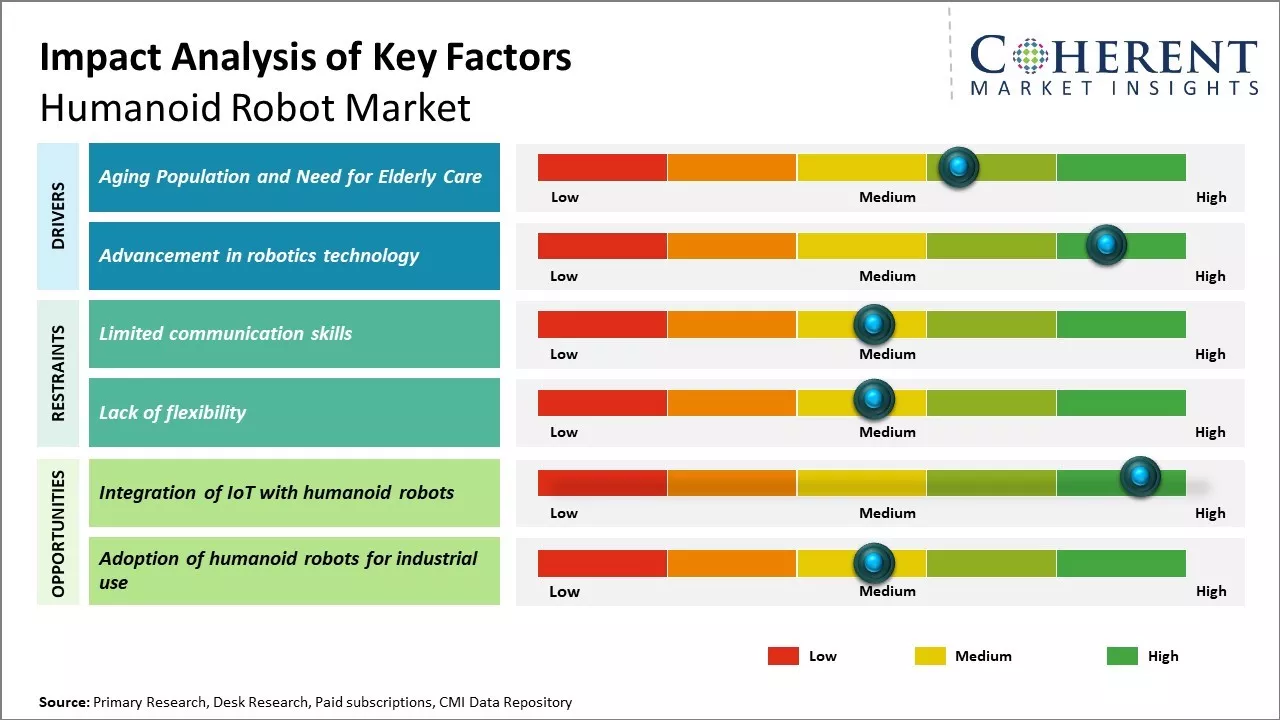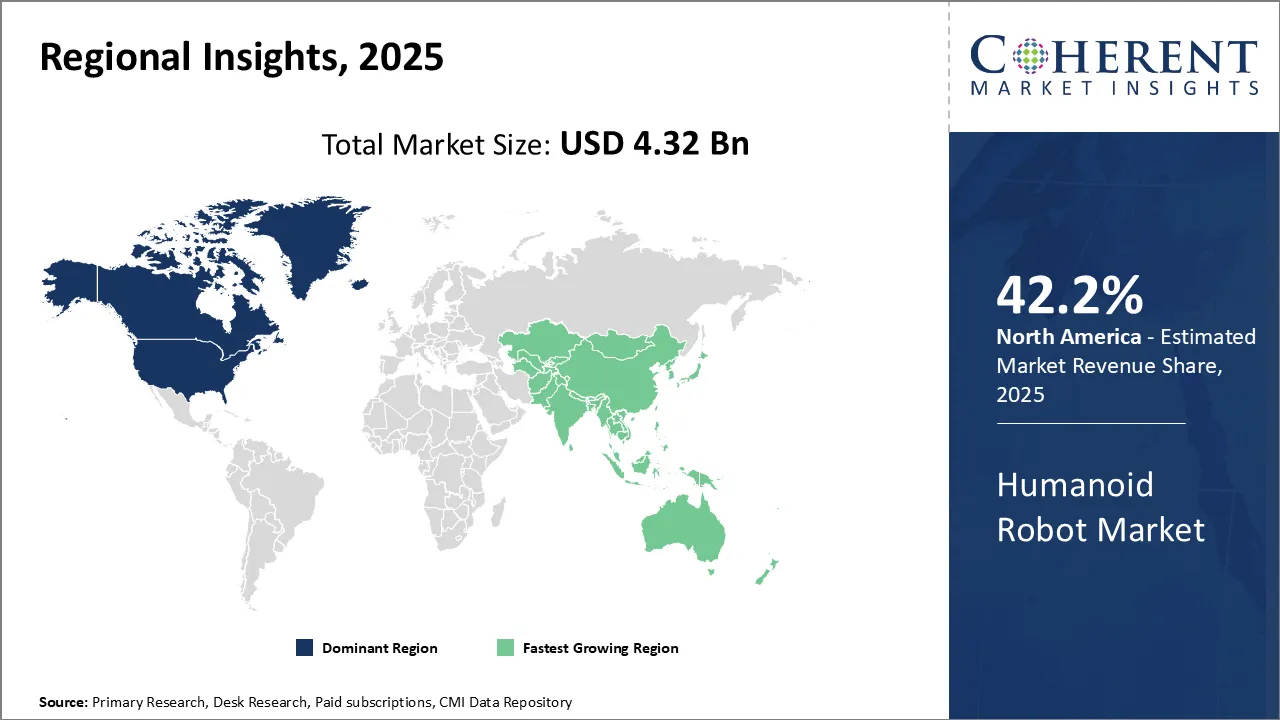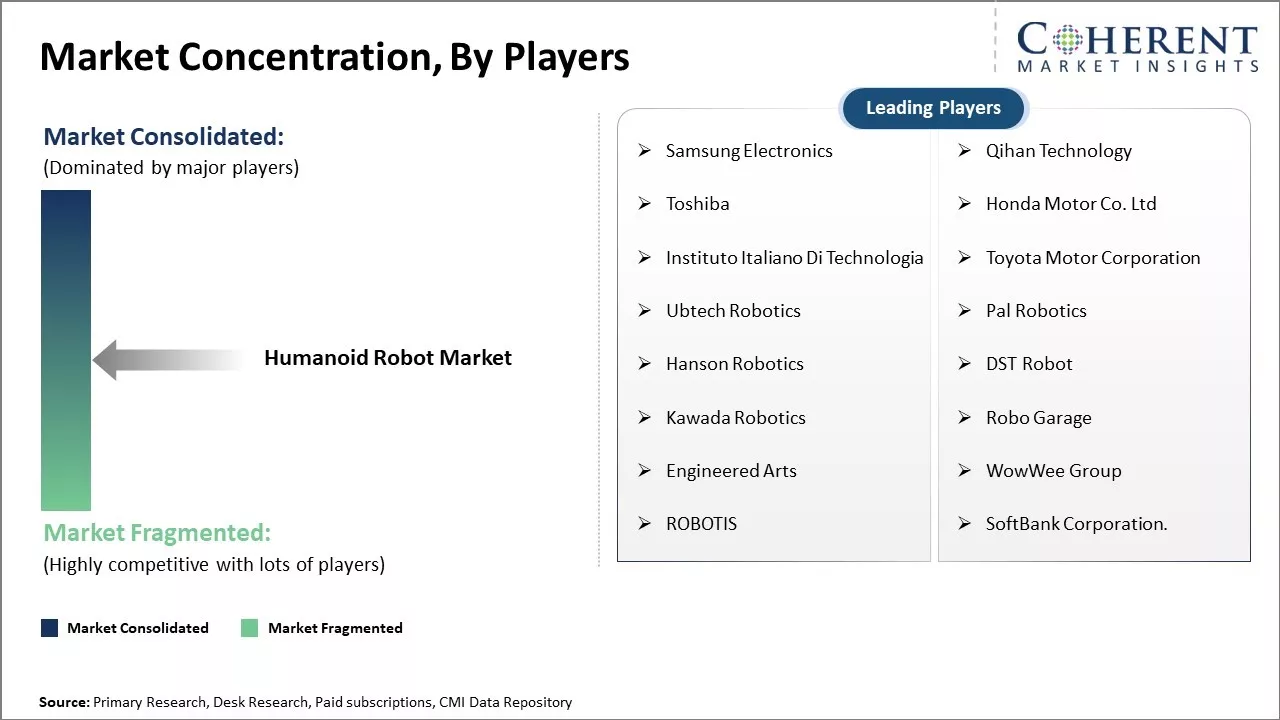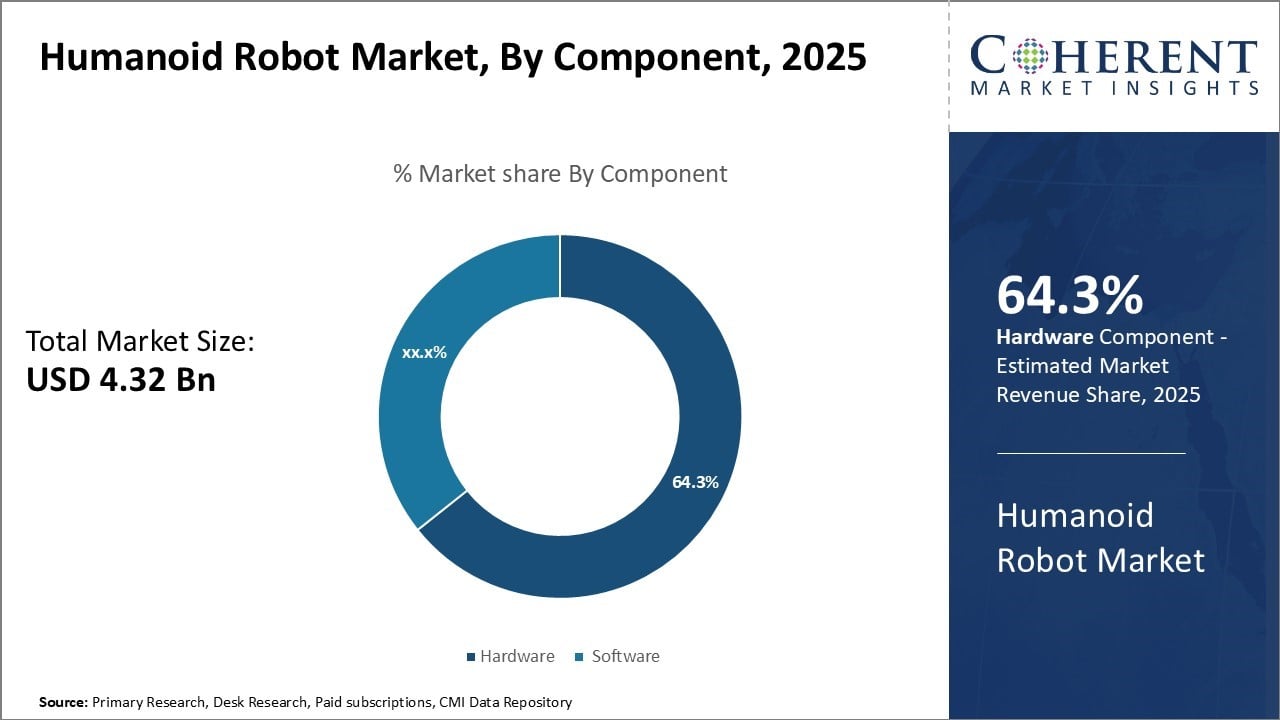Humanoid Robot Market Size and Forecast – 2025 to 2032
Global humanoid robot market is estimated to be valued at USD 4.32 Bn in 2025 and is expected to reach USD 69.74 Bn by 2032, exhibiting a compound annual growth rate (CAGR) of 48.8% from 2025 to 2032.

To learn more about this report, Download Free Sample
Key Takeaways
- Based on Component, Hardware segment is projected to account for 64.3% of the global market in 2025.
- Based on Application, the Personal Assistance & Caregiving segment is expected to capture 35% share of the market in 2025, owing to rising aging populations and staff shortages.
- Based on Motion Type, the Wheel-drive segment is projected to command the highest share of the market in 2025.
- Based on Region, North America is set to dominate the global market with a 42.2% share in 2025.
Market Overview
Rising adoption of humanoid robots across several industry verticals such as healthcare, education, hospitality, retails and others is expected to drive the market growth during the forecast period. Humanoid robots are being used in various applications such as personal assistance and cares, education and entertainment, research and space exploration, and public relation. Rising demand for humanoid robots due to their human-like appearance and intelligence is expected to provide numerous opportunities for market players during the forecast period.
Current Events and Its Impact
|
Current Event |
Description and its Impact |
|
U.S.-China Technology Trade War and Export Controls |
|
|
Breakthrough AI Model Developments and Computing Advances |
|
Uncover macros and micros vetted on 75+ parameters: Get instant access to report
Role of AI (Artificial Intelligence) in Humanoid Robot Market
Artificial Intelligence (AI) plays a pivotal role in driving the growth and evolution of the humanoid robot market. It enables robots to perform complex, human-like tasks such as facial recognition, natural language processing, decision-making, and adaptive learning. By integrating AI, humanoid robots can interpret their environment, engage in real-time conversations, and respond appropriately to social cues—capabilities essential for applications in healthcare, education, customer service, and companionship.
For instance, March 2025, NVIDIA announced a suite of AI technologies designed to accelerate the development of humanoid robots. The portfolio includes Isaac GR00T N1, hailed as the world’s first open and fully customisable foundation model for general-purpose humanoid reasoning and skills.
Humanoid Robot Market Trends
Aging Population and Need for Elderly Care
As life expectancy continues to increase worldwide, the elderly population is growing at an unprecedented rate. According to the data published by United Nations, the number of people aged 60 years and above is expected to double by 2050 and reach nearly 2.1 billion people globally. With declining birth rates, many countries are facing an aging society where the share of younger population is shrinking. This demographic shift poses serious challenges for healthcare systems and family structures traditionally responsible for elderly care.
Advancement in robotics technology
Caring for the elderly people becomes a massive undertaking as these people require assistance for their daily activities and may suffer from limited mobility or health conditions like Alzheimer's. Many families struggle to balance work with providing personalized care and supervision to their aging parents or relatives. Nursing homes and retirement communities provide an option but can be very expensive for most people. This is where humanoid robots come into the picture as a viable alternative for assisting the elderly population.
Robots can perform simple care tasks like dispensing medication on schedule, assisting with bathing or mobility, keeping watch for safety 24/7 and even providing mental stimulation through interaction. Their use can alleviate the physical and mental burden on human caregivers while allowing the elderly to remain in the comfort of their own homes for as long as possible. In June 2025, China launched a pilot program to introduce robots in elderly care, aiming to ease labour shortages. The government has invited organizations to support the integration of robotics into smart elderly care services.
Humanoid Robot Market Insights, By Component - Hardware segment contributes the highest share of the market owing to its indispensability
Among component, hardware segment is estimated to contribute 64.3% of the market share in 2025. Right from the structural frame and joints that enable locomotion to sophisticated sensors and processors that power cognition and movements - specialized hardware components come together to bring robots to life. Provided their complex anthropomorphic designs seeking to replicate human abilities, humanoid robots rely heavily on cutting-edge hardware technologies.
Skeletal structures designed for upright bipedal motion or on-wheel platforms require durable lightweight alloys and precision servomotors. Advanced actuators and hydraulic systems empower articulated movements. Multi-modal sensors incorporating vision, touch, proximity, thermal detection and more allow humanoid robots to perceive their surroundings.
Powerful onboard computers and specialized chips run complex AI algorithms for navigation, object recognition and decision making. Supplementary hardware like wireless modules enable remote operation and connectivity. Batteries with high energy density power the full-day functioning of these power-hungry systems.
In February 2025, Humanoid robot company 1X introduced its next-generation home humanoid, NEO Gamma. The Gamma comes with a host of improvements from hardware to software, as well as a new design the company said is “deeply considerate of life at home” and is designed to be a “useful companion.”
Humanoid Robot Market Insights, By Application - Personal Assistance & Caregiving segment contributes the highest share owing to addressing critical human needs
By application, personal assistance & caregiving segment is estimated to contribute 35% of the market share in 2025. As humanoid robots become increasingly intuitive, safe and helpful, their application in personal assistance segment is rising rapidly. Aging populations and staff shortages increases the need for assistance with daily living activities, company and basic care services. Humanoid robots are uniquely positioned to address these needs through their personable demeanor and mobility.
Companionship prevents loneliness amongst elders while therapeutic robots aid with motor skills rehabilitation. For patients, these can deliver meals, fetch supplies, provide schedule reminders and enable communications. In special needs education, humanoid robots enrich learning and encourage social interactions. Their ability to lift and transfer individuals safely makes them suitable replacements for human caregivers during medical procedures or hygienic activities.
For instance, in January 2025, Intuition Robotics Inc., introduced ElliQ Caregiver Solution, which uses artificial intelligence to help provide care for older adults. The offering includes the ElliQ companion robot and the Caregiver App for remotely managing and monitoring care.
Humanoid Robot Market Insights, By Motion Type- Wheel-drive segment contributes the highest share owing to its stability and maneuverability
By motion type, wheel-drive segment is estimated to contribute market share. Motion mechanisms define a humanoid robot's mobility styles. While bipedal striding resembles humans, it remains a technical challenge requiring acrobatic balancing. In contrast, wheel-based locomotion provides stable, consistent movements ideal for practical applications.
Robots on wheels can navigate various terrains smoothly at adjustable speeds. Omni-directional and swiveling wheels allow 360-degree maneuvering in tight spaces without turning back. This comes handy for tasks like patrolling, inspecting or transporting payloads indoors and outdoors. Wheeled-bases are less likely to tip over from accidental bumps compared to walking robots.
In June 2025, China’s DEEP Robotics launched the LYNX M20, a medium-sized robot with both wheeled and legged mobility, designed for challenging tasks like industrial inspection and emergency rescue.
Regional Insights

To learn more about this report, Download Free Sample
North America Humanoid Robot Market Analysis & Trends
North America has emerged as the dominant region in the global humanoid robot market with estimated 42.2% market share in 2025. The region is home to some of the leading robotics companies such as Boston Dynamics, Anthropic, and Agility Robotics. These companies have been at the forefront of developing cutting-edge humanoid robot technologies for various applications. In addition, large technology giants like Google, Amazon, Microsoft and Apple are increasingly investing in human-like robotics research and development centers in the US, aiming to commercialize humanoid robots over the next decade.
The region also has a highly skilled workforce which is supporting continued innovation in areas like artificial intelligence, computer vision, machine learning and advanced robotics. Government initiatives promoting robotics technologies coupled with presence of early technology adopters have further boosted the regional market. North American universities are collaborating closely with robotics startups to advance research. This strong industry-academia partnership is proving pivotal for consolidating the region's leadership.
In April 2025, Waterloo startup Axibo AI raised $12 million to advance 'Made in Canada' humanoid robots. Known for its 4D volumetric capture technology and clients like Netflix and Apple, Axibo secured $11 million from external investors and $1 million from founders Anoop Gadhrri, Sohaib Al-Emara, and Reiner Schmidt, who began their robotics journey in 2019 with their university's first autonomous vehicle.
Asia Pacific Humanoid Robot Market Analysis & Trends
The Asia Pacific humanoid robot market is rapidly growing, driven by technological advancements in AI and robotics, along with strong government support, especially from countries like China, Japan, and South Korea. China is emerging as a major player, investing billions in humanoid robotics and establishing training centers, while Japan and South Korea continue to innovate with robots like Pepper and ASIMO.
The increasing demand for healthcare companion robots and educational robots is also fueling market growth, positioning the Asia Pacific region as a global leader in humanoid robot development and deployment.
For instance, in November 2024, Addverb, announced its foray into humanoid robotics. The new humanoid robot will be an advanced AI agent capable of processing vast volumes of multi-modal data from vision, audio, and touch inputs.
China Humanoid Robot Market Trends
China, on the other hand, has emerged as the fastest growing regional market for humanoid robots. The government's aggressive 'Made in China 2025' initiative has encouraged both foreign and domestic companies to set up localized production and expand R&D facilities in the country. This is attracting more investments towards developing inclusive and assistive humanoid robots. Chinese technology giants like Baidu, Alibaba and several newer startups have already made progress in building affordable yet capable humanoid designs.
China also has a large manufacturing base and a huge potential consumer market for service robots. The country is investing heavily to automate various industries using collaborative robots that can work alongside humans seamlessly and safely. This is generating significant demand for more human-centric robot designs.
For instance, in July 2025, China announced the launch of world’s first robot that can run by itself 24/7 named “The Walker S2 robot. This robot is made by a Chinese company UBTECH.
India Humanoid Robot Market Trends
The humanoid robot market in India is showing several interesting trends as it develops quickly. Key drivers include growing automation needs in sectors like healthcare, education, retail, and customer service, and increasing R&D activity among startups, universities, and government labs.
For instance, in July 2025, India launched humanoid robotics with Ati Motors' Sherpa Mecha, even as global powers ramp up investments and deployment across manufacturing, services, and defence
Market Concentration and Competitive Landscape

To learn more about this report, Download Free Sample
Analyst Opinion (Expert Opinion)
The global humanoid robot market is expected to witness significant growth over the next decade. North America is dominating the global market driven by growing adoption of humanoid robots across various industries. Asia Pacific, mainly China and India, is fastest growing region in the humanoid robot market owing to strong technological advancements and increasing R&D investments in robotics.
Some of the key drivers propelling the humanoid robot market growth are increasing automation across industries for enhanced productivity and efficiency, rising demand for humanlike robots for service applications in healthcare, hospitality, and entertainment sectors. Additionally, rapid advancement in artificial intelligence, sensors, and machine learning technologies is enabling higher degree of movement, dexterity, and cognitive abilities in humanoid robots.
However, high initial costs of developing and engineering anthropomorphic robots still act as a major restraint for wide adoption. Concerns around data privacy and security with AI-enabled robots is another challenge that needs to be addressed. Conversely, increasing applications of humanoid robots for assisting elderly care, companionship, social interaction presents a promising growth opportunity.
Humanoid Robot Market News
- In September 2025, Humanoid Global Holdings Corp, announced that the company has committed to a strategic investment of US$ 145,000 into Agility Robotics Inc.
- In March 2025, NVIDIA announced a portfolio of technologies to supercharge humanoid robot development, including NVIDIA Isaac GR00T N1, the world’s first open, fully customizable foundation model for generalized humanoid reasoning and skills.
- In June 2025, Hexagon, announced the launch of its all new humanoid robot, AEON, at Hexagon LIVE Global events flagship.
Market Report Scope
Humanoid Robot Market Report Coverage
| Report Coverage | Details | ||
|---|---|---|---|
| Base Year: | 2024 | Market Size in 2025: | USD 4.32 Bn |
| Historical Data for: | 2020 To 2024 | Forecast Period: | 2025 To 2032 |
| Forecast Period 2025 to 2032 CAGR: | 48.8% | 2032 Value Projection: | USD 69.74 Bn |
| Geographies covered: |
|
||
| Segments covered: |
|
||
| Companies covered: |
Samsung Electronics, Qihan Technology, Toshiba, Honda Motor Co. Ltd, Instituto Italiano Di Technologia, Toyota Motor Corporation, Ubtech Robotics, Pal Robotics, Hanson Robotics, DST Robot, Kawada Robotics, Robo Garage, Engineered Arts, WowWee Group, ROBOTIS, SoftBank Corporation. |
||
| Growth Drivers: |
|
||
| Restraints & Challenges: |
|
||
Uncover macros and micros vetted on 75+ parameters: Get instant access to report
Market Opportunity
The humanoid robot market possesses significant growth opportunities as technologies continue to progress. As robots evolve to become more human-like in their abilities, they are opening up new applications for assisting people in their day-to-day lives.
Market Segmentation
- Component Insights (Revenue, USD Bn, 2020 - 2032)
- Hardware
- Software
- Application Insights (Revenue, USD Bn, 2020 - 2032)
- Research & Space Exploration
- Education & Entertainment
- Personal Assistance & Caregiving
- Hospitality
- Search & Rescue
- Others
- Motion Type Insights (Revenue, USD Bn, 2020 - 2032)
- Biped
- Wheel-drive
- Regional Insights (Revenue, USD Bn, 2020 - 2032)
- North America
- U.S.
- Canada
- Latin America
- Brazil
- Argentina
- Mexico
- Rest of Latin America
- Europe
- Germany
- U.K.
- France
- Italy
- Russia
- Rest of Europe
- Asia Pacific
- China
- India
- Japan
- Australia
- South Korea
- ASEAN
- Rest of Asia Pacific
- Middle East & Africa
- GCC Countries
- South Africa
- Rest of Middle East & Africa
- Key Players Insights
- Samsung Electronics
- Qihan Technology
- Toshiba
- Honda Motor Co. Ltd
- Instituto Italiano Di Technologia
- Toyota Motor Corporation
- Ubtech Robotics
- Pal Robotics
- Hanson Robotics
- DST Robot
- Kawada Robotics
- Robo Garage
- Engineered Arts
- WowWee Group
- ROBOTIS
- SoftBank Corporation.
Source:
Primary Research Interviews
- Humanoid Robot Manufacturers and Technology Developers
- Robotics Software and AI Solution Providers
- End-User Industries (Healthcare, Education, Entertainment)
- Robotics Distributors and System Integrators
- Others
Databases
- International Federation of Robotics (IFR) Database
- IEEE Xplore Digital Library
- Robotics Industries Association (RIA) Database
- Others
Magazines
- Robotics & Automation Magazine
- Robot Magazine
- Robotics Business Review
- AI & Robotics Today
- Others
Journals
- International Journal of Humanoid Robotics
- IEEE Transactions on Robotics
- Robotics and Autonomous Systems
- Others
Newspapers
- The Wall Street Journal (Technology Section)
- Financial Times (Tech Industry Coverage)
- TechCrunch
- Reuters Technology News
- Others
Associations
- International Federation of Robotics (IFR)
- Robotics Industries Association (RIA)
- IEEE Robotics and Automation Society
- Association for Advancing Automation (A3)
- Others
Public Domain Sources
- U.S. Patent and Trademark Office (USPTO)
- European Patent Office (EPO)
- Company Annual Reports and SEC filings
- Government Research Publications
- Others
Proprietary Elements
- CMI Data Analytics Tool
- Proprietary CMI Existing Repository of information for last 8 years
Share
Share
About Author
Ankur Rai is a Research Consultant with over 5 years of experience in handling consulting and syndicated reports across diverse sectors. He manages consulting and market research projects centered on go-to-market strategy, opportunity analysis, competitive landscape, and market size estimation and forecasting. He also advises clients on identifying and targeting absolute opportunities to penetrate untapped markets.
Missing comfort of reading report in your local language? Find your preferred language :
Transform your Strategy with Exclusive Trending Reports :
Frequently Asked Questions
EXISTING CLIENTELE
Joining thousands of companies around the world committed to making the Excellent Business Solutions.
View All Our Clients

